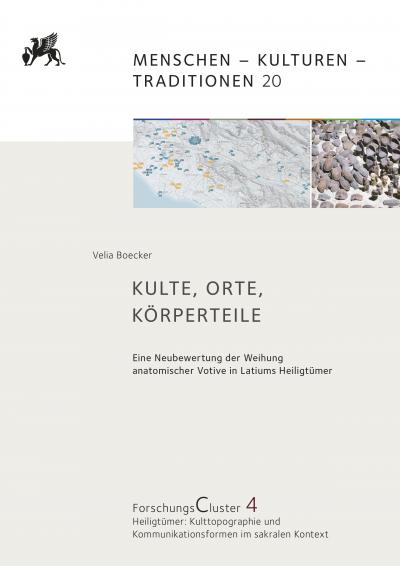Kulte, Orte, Körperteile: Eine Neubewertung der Weihung anatomischer Votive in Latiums Heiligtümer
https://doi.org/10.34780/ku93-c80u
Synopsis
The study focuses on the phenomenon of anatomical votives in sanctuaries of Latium (Italy) dedicated in the 4th to 1st cent. B.C. These votives were hitherto understood as indicators for healing cults. The archaeological contexts though, e.g. the associated finds as well as the topographic position of the sites and their traditions, have hardly been focused yet. Featuring a contextualising approach, the monograph presents the quantitative analysis of more than 100 sites in Latium with a total of over 15.000 anatomical votives. Their connection to environmental parameters as springs, lakes, mountain tops, caves and connections to roads and settlements as well as gender-specific analyses are also considered.
Based on this data the sites can be divided into two groups which differ from their location, the composition of the dedicated votives, the venerated deities and probably the dedicants. The two groups presumably root in local cult traditions. A specific focus as a ›healing cult‹ is not recognisable. The frequently held assumption that the dedication of anatomical votives in central Italy should be regarded as a part of specifically Greek or Roman religion that was adopted into the sanctuaries of Latium during the Roman expansion cannot be confirmed. Instead, it seems plausible that anatomical votives were spread in Latium within local communities with shared or similar religious conceptions, an extensive network and influenced by autochthonous traditions. Thus, the anatomical votives can also be understood as part of an indigenous identity within a broader network of cultural exchange. This change of perspective contributes to new insights into the tradition and subject of archaeological sites formerly addressed as healing cult sites.
Keywords:
Heilkulte, Votive, Terrakotten, Republikanische Zeit (Italien), Lazio (Regione)Chapters
-
Vorwort der Herausgeber*innen
-
Vorwort und Danksagung
-
1 Einleitung
-
1.1 Forschungsgeschichte
-
1.2 Fragestellung
-
1.3 Methodisches Vorgehen
-
1.4 Abgrenzung des Untersuchungsgebietes
-
1.5 Terminologie
-
2 Thematische Einführung
-
2.1 Geografische und chronologische Verteilung von Körperteilweihungen im Mittelmeerraum
-
2.2 Ursprung und Verbreitung der Körperteilweihungen des ELC-Komplexes
-
2.3 Schrift- und Bildquellen
-
2.4 Produktion (Material, Herstellungsprozess, Werkstätten)
-
2.5 Datierung und Überlieferung von Körperteilweihungen
-
2.6 Positionierung im Heiligtum
-
2.7 Kultischer Kontext
-
2.8 Interpretationsansätze der Körperteilweihungen
-
3 Case-Studies: Untersuchung ausgewählter Heiligtümer mit Körperteilweihungen in Latium
-
3.1 Topografischer und historischer Überblick
-
3.2 Zur Auswahl der Heiligtümer
-
3.3 Fundplätze
-
4 Ergebnisse
-
4.1 Quantitative Auswertung der Körperteilweihungen und ihre Vergesellschaftung mit anderen Funden
-
4.2 Die Topografie der Fundstellen
-
4.3 Die Empfänger der Weihgaben
-
4.4 Überregionale Vergleiche
-
4.5 Synthese
-
5 Einordnung
-
5.1 Vergleich mit der griechischen Tradition
-
5.2 Einbindung der Körperteilweihungen in den (kult-)historischen Kontext
-
6 Zusammenfassung, Fazit, Ausblick
-
6.1 English Summary
-
6.2 Riassunto italiano
-
7 Katalog: Kultplätze in Latium
-
7.1 Konkordanztabelle
-
8 Quellen- und Literaturverzeichnis
-
9 Abbildungsverzeichnis
-
Tafeln 1–4




